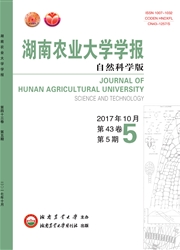

 中文摘要:
中文摘要:
于2011年至2013年,调查黑龙江黑河地区黄褐天幕毛虫监测样地的立地因子和林分因子,分析立地因子和林分因子及生物多样性指数对黄褐天幕毛虫平均虫口密度的影响。单因素方差分析与Tukey检验表明,阴坡黄褐天幕毛虫口密度显著高于阳坡、半阳坡、半阴坡的;海拔301~400 m黄褐天幕毛虫平均虫口密度显著高于海拔401~500 m和501 m以上的;郁闭度0.5黄褐天幕毛虫平均虫口密度显著高于郁闭度0.4、0.6、0.7的,郁闭度0.6的平均虫口密度显著高于郁闭度0.4的;蒙古栎比例60%以上的黄褐天幕毛虫平均虫口密度显著高于0~29%和30%~59%的。坡位、坡度对黄褐天幕毛虫平均虫口密度无显著影响。中坡位、阴坡、斜坡、海拔301~400 m、郁闭度0.5、蒙古栎比例高于60%条件下,黄褐天幕毛虫平均虫口密度最大,上坡位、半阴坡、缓坡、海拔高度〉501 m、郁闭度0.4、蒙古栎比例30%~59%条件下,黄褐天幕毛虫平均虫口密度最小。相关分析显示,坡位、坡向、郁闭度、Simpson指数、Shannon–Wiener指数对黄褐天幕毛虫平均虫口密度呈正向影响,坡度、海拔、蒙古栎比例对黄褐天幕毛虫平均虫口密度呈负向影响。
 英文摘要:
英文摘要:
In Heihe area of Heilongjiang, site factors and stand factors in monitored sample plots of Malacosoma neustria testacea Motschulsky were investigated from 2011 to 2013, the effects of these factors and the biodiversity index on average population density of Malacosoma neustria testacea Motschulsky were analyzed. One-way analysis of variance(ANOVA) and Tukey tests showed that average population of Malacosoma neustria testacea Motschulsky in shady aspect was significantly higher than that in the sunny aspect, semi-sunny aspect and semi-shady aspect; average population of Malacosoma neustria testacea Motschulsky with elevation 301-400 m was significantly higher than that with elevation 401-500 m and 501 m above; average population of Malacosoma neustria testacea Motschulsky with canopy density of 0.5 was significantly higher than that of 0.4, 0.6 and 0.7, with canopy density of 0.6 was significantly higher than that of 0.4; average population of Malacosoma neustria testacea Motschulsky with the proportion of Quercus mongolica Fisch. ex Ledeb. above 60% was significantly higher than that with 0-29% and 30%-59%. Slope position and gradient showed no significant influence on average population density of Malacosoma neustria testacea Motschulsky. The average population density of Malacosoma neustria testacea Motschulsky was the highest under middle gradient, shady slope, steep hill, elevation 301-400 m, canopy density 0.5 and proportion of Quercus mongolica Fisch. ex Ledeb. 〉60%. The average population density of Malacosoma neustria testacea Motschulsky was the smallest under upper high slope, semi-shady slope, flat gradient, elevation 〉501 m, canopy density 0.4, and proportion of Quercus mongolica Fisch. ex Ledeb. 30%-59%. The results of correlation indicated that slope position, aspect, canopy density, Simpson index and Shannon-Wiener index demonstrated positive impact on the average population density of Malacosoma neustria testacea Motschulsky, while gradient, elevation and the proportion of Quercus mongolic
 同期刊论文项目
同期刊论文项目
 同项目期刊论文
同项目期刊论文
 期刊信息
期刊信息
